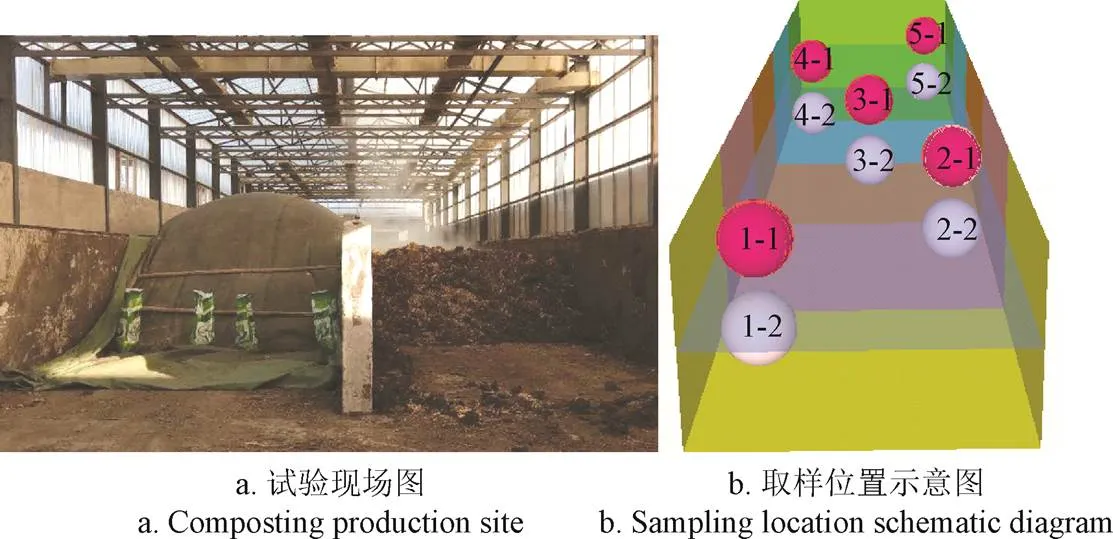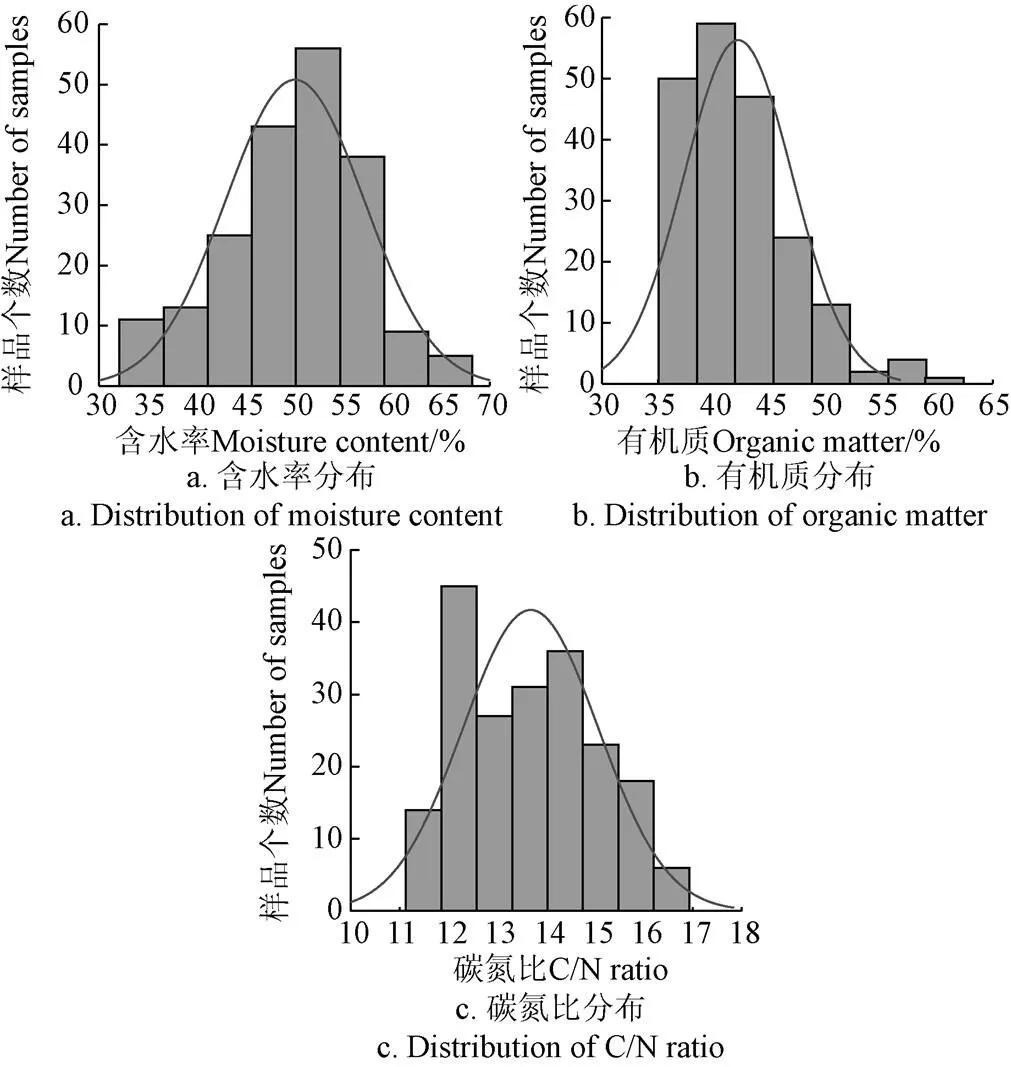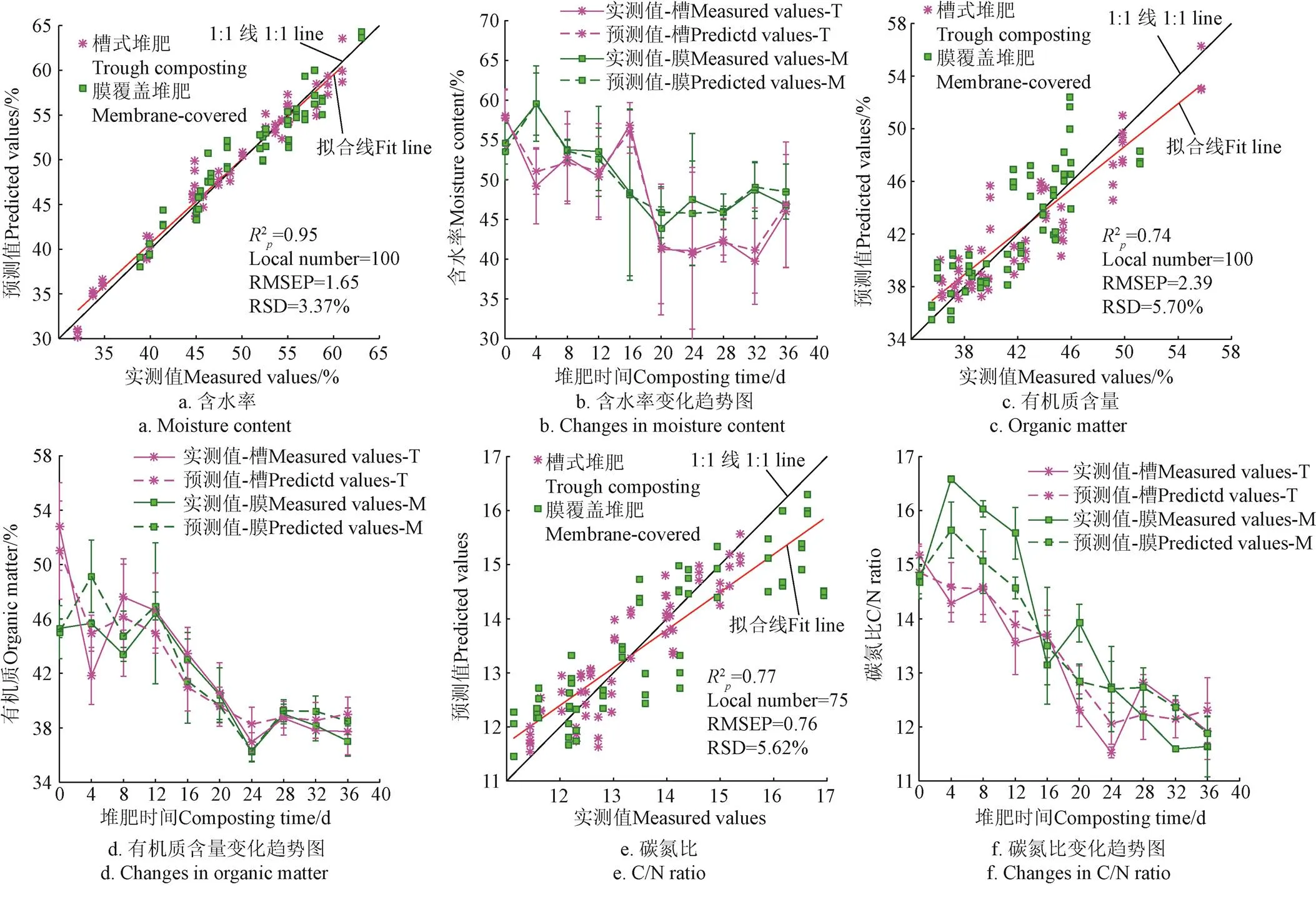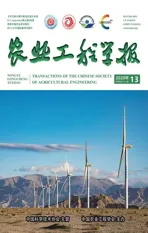基于NIRS和Local PLS算法的堆肥关键参数实时动态分析
2020-08-12黄圆萍沈广辉廖科科吴亚蓝韩鲁佳杨增玲
黄圆萍,沈广辉,廖科科,吴亚蓝,韩鲁佳,杨增玲
基于NIRS和Local PLS算法的堆肥关键参数实时动态分析
黄圆萍,沈广辉,廖科科,吴亚蓝,韩鲁佳,杨增玲※
(中国农业大学工学院,北京 100083)
为对不同堆肥工艺堆肥全过程关键参数进行实时动态分析,该研究以牛粪便和玉米秸秆为原料,进行规模化槽式和膜覆盖好氧堆肥,采集堆肥全过程样本,分析了2种堆肥技术堆肥全过程中含水率、有机质含量和碳氮比等关键参数的变化,并结合Local PLS算法建立了2种堆肥技术堆肥全过程中上述参数的通用速测模型,得出以下结果:1)2种主要工艺关键参数数值及变化规律均不同,且在整个堆肥过程中有显著性变化(<0.05);2)所建立的Local PLS模型的RPD(Ratio of Prediction to Deviation)为4.47,RSD(Relative Standard Deviation)为3.37%,可达到很好的预测效果;有机质含量和碳氮比的2分别为0.74和0.77,RPD大于1.5,RSD小于10%,模型可用于定量预测;近红外预测值与实测值随堆肥时间的变化趋势具有较好的一致性,可实现规模化堆肥过程中关键参数的实时分析。
近红外;堆肥;算法;过程分析;槽式堆肥;膜覆盖堆肥;关键参数;Local PLS
0 引 言
中国每年产生农业废弃物50多亿t[1],其中,畜禽粪污38亿t,农作物秸秆近9亿t,给中国的环境污染治理带来严峻的挑战。畜禽粪便和农作物秸秆富含有机质和氮、磷、钾等养分,是农业生态系统中十分宝贵的生物质资源[2]。好氧堆肥技术是解决畜禽粪便和农作物秸秆等农业固体废弃物污染问题并实现其资源化和无害化利用的有效途径之一[3]。在众多好氧堆肥技术中,槽式好氧堆肥由于具有处理量大和堆肥周期短等优点,是中国目前主流的规模化堆肥技术[4-7];而膜覆盖好氧堆肥则是一种改良的强制通风静态堆肥技术,其采用半渗透膜覆盖发酵堆体表面,使堆体发酵处在微正压环境下[8-9],可实现好氧堆肥过程发酵均匀、高效节能以及温室气体减排等效果[10-16],是目前逐步受到关注的新型好氧堆肥技术之一。
堆肥是在微生物的作用下发生复杂物理化学变化的过程,受温度[17]、含水率[18-19]、有机质含量[20]和碳氮比[21-22]等参数的影响。在整个堆肥过程中如能对上述参数实现快速实时检测,可为堆肥工艺优化、堆肥过程控制和堆肥品质提高提供保障。近红外光谱分析技术(NIRS,Near Infrared Spectroscopy)是目前发展迅速和具有前景的快速实时分析技术之一,国内外已有很多学者基于近红外光谱结合偏最小二乘算法(PLS,Partial Least Squares)构建了污泥堆肥[23-26]和畜禽粪便堆肥[27-32]过程中酸碱度、电导率、有机质、有机碳、碳氮比等参数的速测模型,都取得了良好的效果。但目前的研究都是针对某一种堆肥技术建立的模型,因不同的堆肥技术会大大增加堆肥过程中样品的复杂性,如果用PLS构建适于不同堆肥技术的通用模型,在避免模型过拟合的情况下,可能存在通过增加主因子数来提高模型预测决定系数,甚至可能因为选择太多的主因子数出现模型过拟合、模型预测精度降低等问题[33]。而局部加权回归[34]、LOCAL[35]、局部偏置回归[36]等局部算法的开发应用,可有效解决上述问题。Shen等[37]提出了基于PLS得分的Local PLS算法,采用压缩后的数据建立PLS模型,既节约了计算时间又提高了模型的准确性。
本研究选用奶牛粪便和玉米秸秆为原料,进行规模化槽式和膜覆盖好氧堆肥,在整个堆肥过程中采集样品,结合LocalPLS算法建立2种堆肥技术堆肥过程中含水率、有机质含量和碳氮比等关键参数的通用速测模型,探究基于近红外光谱技术实时监控不同堆肥技术堆肥过程中关键参数的可行性。
1 材料与方法
1.1 样品的采集与制备
试验样品在北京市北郎中有机肥料厂采集,发酵槽为2条相邻的槽,长44 m,宽3.85 m,高1.8 m,所采用的原料是周边奶牛养殖场生产的奶牛粪便,及打捆玉米秸秆,两者比例调至质量比大约10:1,并添加40%的腐熟堆肥用于调节水分,初始含水率为55%,初始碳氮比为15。如图1a所示,一条为槽式好氧发酵,一条为膜覆盖好氧发酵。2条槽的原料配比、通风和翻堆情况一致。整个堆肥周期持续36 d,样品采集覆盖了从堆肥原料到堆肥腐熟的全过程,在发酵的第0、4、8、12、16、20、24、28、32和36天采集样品。考虑到堆体在不同空间位置发酵情况的差异,取样时,在发酵槽长度方向均匀选择5个点,在深度方向分上(深度0~30 cm)、下(深度90~120 cm)2层取样,共取样10个,如图1b所示。2条槽10次共采集样品200个,每个样品质量约1 kg,置于冷藏柜中−20℃下存放备用。测定分析时,样品自然解冻至室温后混合均匀,进行光谱采集及化学值测定,样品经干燥后粉碎过40目(0.425 mm)筛用于后续分析。

注:图中编号1~5分别为发酵槽长度方向上的5个取样点,1-1和1-2,2-1和2-2,3-1和3-2,4-1和4-2,5-1和5-2分别为每个取样点在深度方向的上下两层。
1.2 关键参数测定方法
使用PT100温度传感器测定堆体上(深度35 cm)、中(深度70 cm)、下(深度105 cm)3个不同位置的温度。
含水率采用烘干法,称取鲜样100 g,在干燥箱(上海精宏实验设备有限公司,中国)105℃恒温干燥24 h,根据干燥前后质量损失计算含水率。
有机质采用灼烧减量法,称取1.0 g左右的干燥粉碎样品,在马弗炉(上海精宏实验设备有限公司,中国)575℃灼烧6 h,根据灼烧前后质量损失计算有机质。
碳氮比用元素分析仪(Elementer公司,德国)测定,称取40.0 mg干燥粉碎样品,采用元素分析仪CHNS模式标准方法测定。
种子发芽指数参考李季等[38]采用的发芽试验法,将黄瓜种子(中蔬种业科技有限公司,中国)在恒温培养箱中30 ℃避光培养48 h,根据发芽率和根长计算。
1.3 样品近红外光谱采集
使用傅里叶变换近红外光谱仪(Perkin Elmer公司,美国)采集样品光谱,光谱采集范围为10 000~4 000 cm-1、扫描间隔为8 cm-1、扫描次数为32次。采样时,将样品装满仪器配套的样品杯并刮平,采用积分球附件在旋转模式下采集光谱,每个样品重复装填3次扫描3条光谱,共获得600条光谱。
1.4 数据统计分析
采用IBM SPSS Statistics 25.0(IBM公司,美国)对样品的化学值进行正态分布检验,进而对槽式和膜覆盖2种不同技术堆肥过程关键参数进行显著性分析,分析堆肥关键参数随时间的变化并比较2种不同堆肥技术堆肥过程关键参数的差异性。
1.5 主成分分析和LocalPLS模型的建立与评价
运用主成分分析(Principal Component Analysis,PCA),将规模化槽式和膜覆盖堆肥过程所获得的数据矩阵转换新的正交变量,以检测样品的所属模式、分类以及所含物质之间的相似性或差异[39]。
参考Shen[37]的方法构建Local PLS模型。首先,将样品分为校正集和预测集,为使校正集和验证集的样品均覆盖2种堆肥技术的堆肥全过程,采集的样品中,以堆体长度方向2号位置(图1b中2-1和2-2)采集的40个样品作为预测集,其余的160个样品作为校正集;其次,选用预处理方法,根据预测均方根误差(RMSEP)最小确定潜变量数,构建堆肥过程含水率、有机质含量和碳氮比的PLS模型,获取校正集和预测集光谱的得分矩阵;然后,计算预测集样品光谱得分与校正集光谱得分的欧氏距离,按距离排序,从校正集中选择与预测样品光谱得分距离最近的选择建模的光谱条数(50、75、100、125、150、175、200)条光谱得分;最后,采用选择的条光谱得分及其对应的化学值构建LocalPLS模型,预测未知样品,根据RMSEP最小确定最佳的值。
参考Saeys等[40]和Mouazen等[41]的方法,采用模型决定系数(2)和相对分析误差(RPD)进行模型的评价,即:当2>0.9,RPD>3时,认为该模型非常优秀;当0.82≤2≤0.9,2.5≤RPD≤3.0时,认为该模型效果良好;当0.66≤2≤0.81,2.0≤RPD<2.5时,模型可进行近似定量预测;当0.5≤2≤0.65,1.5≤RPD<2.0时,认为该模型只能进行高低浓度鉴别;当2<0.5,RPD<1.5时,认为模型不可用。并结合RSD进行综合评价,当RSD<5%时模型效果良好,RSD<10%时模型可用于定量分析。
RPDSD/RMSEP (1)
RSD=RMSEP/MEAN×100% (2)
式中SD为验证集化学测量值的标准差,MEAN为验证集化学测量值的平均值。
数据处理采用PLS Toolbox 以Matlab 2015a(Mathworks公司,美国)为平台。
2 结果与分析
2.1 不同技术堆肥试验效果分析
根据温度传感器记录的温度数据可知,堆体发酵情况良好,最高温度在70 ℃以上,且55 ℃以上高温持续时间超过10 d,符合国家粪便卫生化处理要求(GB 7959-2012)。根据发芽指数的结果显示,槽式和膜覆盖堆体的种子发芽指数在堆肥结束时均在80%以上[38],表明堆肥完全腐熟。
2.2 不同堆肥技术堆肥过程关键参数统计分析
由含水率、有机质和碳氮比含量的正态分布检验结果可知,含水率KS检验和SW检验的值分别为0.077和0.089,大于0.05,因此含水率含量服从正态分布,有机质和碳氮比含水率KS检验和SW检验的值小于0.05,其含量不服从正态分布。但所采集的样品为槽式和膜覆盖2种规模化堆肥技术堆肥全过程样品,化学值分布是堆肥物料自然发酵的分布状态,由化学值含量分布直方图(图2)可知,三者的含量基本服从正态分布,校正集和验证集样品均覆盖了堆肥的全过程,满足过程分析的需求。
对2种工艺堆肥过程中含水率、有机质含量和碳氮比进行显著性分析,结果如表1所示,不同堆肥技术相应关键参数间具有显著性差异(<0.05);同一技术不同发酵时间的关键参数间也具有显著性差异(<0.05)。

图2 堆肥过程关键参数含量的分布

表1 槽式和膜覆盖堆肥过程关键参数
注:±表示同一天采集的10样品的化学测量值的平均值和标准偏差;堆肥技术栏中,不同技术上标的不同大写字母表示不同技术相应关键参数间具有显著性差异(<0.05);堆肥时间栏中,不同小写字母表示不同发酵时间的关键参数间具有显著性差异(<0.05)。
Note: ± indicates the average value and standard deviation of the chemical measurement values of 10 samples collected on the same day; In the column of composting technology, different capital letters on different technologies indicate that there are significant differences between the corresponding key parameters of different technologies (<0.05); In the compost time column, different small letters indicate that there are significant differences between the key parameters of different fermentation time (<0.05).
堆体含水率随着堆肥的进行在逐渐下降。0~20 d含水率持续下降,是由于堆体处于升温和高温阶段,水分散失较大,水分蒸发损失大于有机物分解产生的水分;第20 天含水率骤降,是由于曝气系统失灵,持续通风所致;21~36 d堆体含水率有所回升,是由于温度降低,微生物分解有机质产生的水分高于由温度、通风引起的水分蒸发损失。比较两种堆肥技术,整个堆肥过程中膜覆盖堆体的含水率均高于槽式堆体的,主要由于功能膜能够阻截一部分水分,在膜内形成一层水膜,使得水分再次回到堆体中。
堆肥原料的初始有机质含量为48%,随着堆肥的进行,微生物生命活动消耗有机质,堆体中的有机质含量在逐渐减少,在8~20 d快速降解,在堆肥结束时降解到38%左右。比较2种堆肥技术,整个堆肥过程中膜覆盖堆体的有机质含量略高于槽式堆体。
堆肥原料的初始碳氮比为15,与槽式堆肥技术相比,膜覆盖堆体的碳氮比在堆肥初期呈上升趋势,主要是因为堆肥初期堆体中微生物的活动需要消耗大量的氮元素,而堆体中的微生物活性较差,对碳的消耗较慢;当堆肥进入高温期后,堆体中的微生物就开始快速消耗碳源,因此堆体中的碳氮比就开始明显下降。进入腐熟阶段,膜覆盖堆肥和槽式堆肥一样,碳氮比不断下降并稳定在12左右,便于有机肥的储存。
总体而言,含水率在33.44%~68.22%,有机质35.07%~62.49%,碳氮比11~17。由于牛粪纤维含量较高,不易腐解,有机质和养分含量较低,C/N比约为13,不能满足发酵所需要的C/N比为25~30的条件[42],所以需要添加一定C/N较高的辅料(秸秆、菌渣、锯末等)将其调配到适合发酵的C/N。本试验中添加玉米秸秆用于调节碳氮比和增加孔隙率。由于堆肥过程中玉米秸秆较牛粪更难腐熟,因此没有大量添加玉米秸秆提高碳氮比。与文献中碳氮比在12~20、15~30相比[42-45],本研究的初始碳氮比和整个堆肥过程碳氮比的范围较低,因此碳氮比的模型效果在较大指标范围内的预测效果会受到限制。与文献中含水率控制在25%~75%,有机质含量30%~70%相比,含水率和有机质含量范围较小,但由于取样仅涉及了堆肥过程,堆肥后熟至成品的阶段含水率和有机质会继续降解含量会降低,因此含水率和有机质含量基本符合正常的堆肥工艺,可以满足过程分析的需求。
2.3 样品光谱主成分分析
图3为槽式和膜覆盖好氧堆肥过程样品光谱在第二主成分的载荷和得分,由载荷分布情况(图3a和图3c)可知,光谱差异主要由C-H键(7 168 cm-1),O-H键(5 285 cm-1)和C=O键(5 263 cm-1)振动引起[24]。得分图中的每个线框代表同一天内不同取样点采集的10个样品,不同线框样品处在堆肥过程的不同发酵阶段。图2b为槽式好氧堆肥过程样品光谱的PC2得分,由图可知,槽式好氧堆肥初期,堆体样品混合较为均匀,不同取样点的样品差异较小,随着堆肥的进行,堆体在不同取样点的发酵差异性增加。图2d为膜覆盖好氧堆肥过程样品光谱的PC2得分,由图可知,膜覆盖好氧堆肥过程中,堆体在不同取样点的发酵差异性先增加后减小,在堆肥后期样品的变异性变小,说明覆膜使得堆体空气分布更均匀,堆体的不同位置发酵较均匀。
2.4 堆肥过程关键参数近红外速测Local PLS模型
表2为采用600条光谱(校正集480条,预测集120条)构建的2种不同堆肥技术堆肥过程关键参数的PLS模型和Local PLS模型结果。由表可知,堆肥过程关键参数的相对标准偏差RSD值均小于10%,说明所构建的模型可用于槽式和膜覆盖好氧堆肥过程中含水率、有机质含量和碳氮比的快速检测。其中,含水率的2为0.95,RPD为4.47,RSD为3.37%,可达到很好的预测效果;有机质含量和碳氮比的2分别为0.74和0.77,RPD大于1.5,RSD小于10%,模型可用于定量预测。这与含水率、有机质和碳氮比含量的正态性检验结果一致。与PLS模型相比,Local PLS模型只需要与预测样品光谱距离相近的100条(含水率、有机质含量参数)或75条光谱(碳氮比参数)就能达到PLS模型用480条光谱得到的效果,且在对未知样品进行预测时,Local PLS模型表现出更优越的稳定性和准确性,预测均方根误差RMSEP和相对分析误差RSD均更小。

注:纵坐标括号内为PC2得分。 Note: The score of PC2 is in ordinate bracket.

表2 槽式和膜覆盖堆肥关键参数PLS和Local PLS模型结果
注:SNVD:SNV+Detrend,标准正态变量+去趋势校正;S-G:平滑;Autoscale:自动标尺化。
Note: SNVD: SNV+Detrend, standard normal variable + detrend correction; S-G: Savitzky-Golaysmoothing; Autoscale: automatic scaling.
为直观地分析Local PLS的计算原理,以预测集样品中含水率化学测量值的最小值和最大值为例分析用Local PLS模型建模时选用样品的情况,结果如图3所示。图中红色圆点为含水率化学测量值最小或最大的预测样品,蓝色三角形点为Local PLS模型定标时未选择的样品,而Local PLS定标所选用的100个样品则采用不同颜色形状表示了样品所处的堆肥阶段,并且括号内数据给出了每个阶段的样品数量。
图4a为预测含水率极小值样品(堆肥第24天)Local PLS定标选用样品的结果,由散点图可知,所选择的100个样品的含水率在30%~50%之间,与预测样品的含水率(32.08%)相近,选择的样品主要集中在20~32 d,其中,堆肥24 d的样品19个,堆肥20和28 d的样品14个,堆肥32 d的样品12个,与预测样品所处的堆肥阶段相近。图4b为预测含水率极大值样品(堆肥第4天)Local PLS定标所用样品的结果,由散点图可知,所选择的100个样品的含水率在50%~70%之间,与预测样品的含水率(63.06%)相近,选择的样品主要集中在0~16 d,其中,堆肥12 d的样品20个,堆肥4 d的样品16个,堆肥16 d的样品14个,与预测样品所处的堆肥阶段相近。由上述分析可知,基于Local PLS算法在定标时选择与预测样品光谱得分更近的样品进行建模,所选样品与预测样品的化学值含量和所处的堆肥阶段更接近,预测结果更加准确,模型稳定性好,同时,采用得分进行建模还可以减少运算量,大大提高计算速度。
2.5 基于Local PLS模型对堆肥过程关键参数进行监控分析
图5为预测集样品的Local PLS近红外预测值和实测值的模型散点图(第一列)及随堆肥时间关键参数近红外预测值和实测值变化趋势图(第二列)。
模型散点图中,红色直线为拟合线,黑色直线为1:1线,粉红色星点代表槽式好氧堆肥样品,绿色正方形点代表膜覆盖好氧堆肥样品;变化趋势图中,实线为实测值变化趋势,虚线为近红外预测值的变化趋势。

注:括号内数字为样品个数。

图5 槽式和膜覆盖好氧堆肥关键参数Local PLS模型散点图及变化趋势图
模型散点图可以直观反映模型结果,拟合线和1:1线的重合度越高,模型效果越好。如图5a所示,拟合线和1:1线接近重合,散点紧密分布在拟合线和1:1线附近,因而含水率模型预测效果很好。
变化趋势图,不仅可以反映不同堆肥技术堆肥过程关键参数的变化趋势,通过与实验室测定值的趋势相比也能反映近红外模型的精确性。如图5b所示,不同堆肥技术堆肥过程中含水率的近红外预测值与实测值随堆肥时间的变化趋势均具有很好的一致性。且近红外预测值与实测值之间的偏差很小,说明含水率的预测结果准确性很高。
由图5c和图5e可知,虽然有机质含量和碳氮比拟合线和1:1线有一定偏差,校正集和验证集的散点也较为离散,模型的精度还有待提高,但如图5d和图5f所示,它们的近红外预测值与实测值随堆肥时间的变化趋势是一致的,因此建立Local PLS模型可以对堆肥过程中的这些参数的变化进行实时检测。
综上,本文所建立的Local PLS模型可实现槽式和膜覆盖好氧堆肥整个堆肥过程中关键参数的实时监控。
3 结 论
本研究以规模化槽式和膜覆盖好氧堆肥全过程样品为研究对象,分析了2种堆肥技术堆肥全过程中含水率、有机质含量和碳氮比等关键参数的变化,并结合Local PLS算法建立了2种堆肥技术堆肥全过程中上述参数的通用速测模型,得出以下结论:
1)2种主要工艺关键参数数值及变化规律均不同,且在整个堆肥过程中有显著性变化(<0.05),槽式堆肥的含水率含量在33.44%~64.27%,有机质35.49%~57.98%,碳氮比11.24~15.94,膜覆盖堆肥的含水率含量在38.58%~68.22%,有机质35.07%~62.49%,碳氮比11.13~16.93,膜覆盖堆肥过程中三者的含量略高与槽式堆肥;
2)所建立的Local PLS模型,含水率的2为0.95,相对分析偏差RPD为4.47,相对标准偏差RSD为3.37%,可达到很好的预测效果;有机质含量和碳氮比的2分别为0.74和0.77,RPD大于1.5,RSD小于10%,模型可用于定量预测。且其近红外预测值与实测值随堆肥时间的变化趋势具有较好的一致性,可实现不同工艺规模化堆肥过程中关键参数的实时动态分析。
[1] 郑露露,闫晓明,陶敬,等. 农业固体废弃物循环利用现状及循环利用方式[J]. 浙江农业科学,2016,1(7):1112-1114.
[2] 陈玉华,田富洋,闫银发,等. 农作物秸秆综合利用的现状、存在问题及发展建议[J]. 中国农机化学报,2018,39(2):67-73.
Chen Yuhua, Tian Fuyang, Yan Yinfa, et al. Current status, existing problems and development suggestions for comprehensive utilization of crop straw[J]. Journal of Chinese Agricultural Mechanization, 2018, 39(2):67-73. (in Chinese with English Abstract)
[3] 王晓鹏,王占川. 农业固体废弃物的形成及资源化利用的研究[J]. 畜牧与饲料科学,2015(1):65-67.
Wang Xiaopeng, Wang Zhanchuan. The formation and resource utilization of agricultural solid wastes[J]. Animal Husbandry and Feed Science, 2015(1): 65-67. (in Chinese with English Abstract)
[4] 徐鹏翔,孙敏捷,李季. 规模化肉牛场粪污收集与堆肥处理工艺设计[J]. 农业工程学报,2016,32(2):213-217.
Xu Pengxiang, Sun Minjie, Li Ji. Feces collection and composting technological design on scaled beef cattle farms[J]. Transactions of the Chinese Society of Agricultural Engineering (Transactions of the CSAE), 2016, 32(2): 213-217. (in Chinese with English Abstract)
[5] 夏炜林,黄宏坤,漆智平,等. 不同堆肥方式对奶牛粪便处理效果的试验研究[J]. 农业工程学报,2006,22(增刊2):215-219.
Xia Weilin, Huang Hongkun, Qi Zhiping,et al. Experimental studies on dairy manure treatment by static bed composting and microbe reagent inoculating[J]. Transactions of the Chinese Society of Agricultural Engineering (Transactions of the CSAE), 2006, 22(Supp.2): 215-219. (in Chinese with English Abstract)
[6] Zeng J, Shen X, Han L, et al. Dynamics of oxygen supply and consumption during mainstream large-scale composting in China[J]. Bioresource Technology, 2016, 220: 104-109.
[7] Zeng J, Shen X, Sun X, et al. Spatial and temporal distribution of pore gas concentrations during mainstream large-scale trough composting in China[J]. Waste Management, 2018, 75: 297-304.
[8] Ma S, Fang C, Sun X, et al. Bacterial community succession during pig manure and wheat straw aerobic composting covered with a semi-permeable membrane under slight positive pressure[J]. Bioresource Technology, 2018: 221-227.
[9] Ma S, Fang C, Sun X, Han L, He X, Huang G. Bacterial community succession during pig manure and wheat straw aerobic composting covered with a semi-permeable membrane under slight positive pressure[J]. Bioresource Technology, 2018, 259: 221-227.
[10] Levis J W, Barlaz M A. What is the most environmentally beneficial way to treat commercial food waste[J]. Environmental Science & Technology, 2011, 45(17): 7438-7444.
[11] 化党领,刘方,李国学,等. 翻堆与覆盖工艺对猪粪秸秆堆肥性质的影响[J]. 农业工程学报,2011,27(12):210-216.
Hua Dangling, Liu Fang, Li Guoxue , et al. Effect of turning and covering techniques on pig manure-straw composting property[J]. Transactions of the Chinese Society of Agricultural Engineering (Transactions of the CSAE), 2011, 27(12): 210-216. (in Chinese with English Abstract)
[12] 江滔,Schuchardt F,李国学. 冬季堆肥中翻堆和覆盖对温室气体和氨气排放的影响[J]. 农业工程学报,2011,27(10):221-226.
Jiang Tao, Schuchardt F, LiGuoxue . Effect of turning and covering on greenhouse gas and ammonia emissions during the winter composting[J]. Transactions of the Chinese Society of Agricultural Engineering (Transactions of the CSAE), 2011, 27(10): 221-226. (in Chinese with English Abstract)
[13] 孙晓曦,崔儒秀,马双双,等. 智能型规模化膜覆盖好氧堆肥系统设计与试验[J]. 农业机械学报,2018,49(10):363-369.
Sun Xiaoxi, Cui Ruixiu, Ma Shuangshuang, et al. Design and Test on Large-scale Semi-membrane-covered Compost System[J]. Transactions of the Chinese Society for Agricultural Machinery, 2018, 49(10): 356-362. (in Chinese with English Abstract)
[14] Sun X, Ma S, Han L, et al. The effect of a semi-permeable membrane-covered composting system on greenhouse gas and ammonia emissions in the Tibetan Plateau[J]. Journal of Cleaner Production, 2018, 204: 778-787.
[15] 马双双,孙晓曦,韩鲁佳,等. 功能膜覆盖好氧堆肥过程氨气减排性能研究[J]. 农业机械学报,2017(11):349-354.
Ma Shuangshuang, Sun Xiaoxi, Han Lujia, et al. Reduction of ammonia emission during membrane-covered aerobic composting[J]. Transactions of the Chinese Society for Agricultural Machinery, 2017, 2017(11): 349-354. (in Chinese with English Abstract)
[16] Ma S, Sun X, Fang C, et al. Exploring the mechanisms of decreased methane during pig manure and wheat straw aerobic composting covered with a semi-permeable membrane[J]. Waste Management, 2018, 78: 393-400.
[17] Raj D, Antil R. Evaluation of maturity and stability parameters of composts prepared from farm wastes[J]. Archives of Agronomy and Soil Science, 2012, 58(8): 817-832.
[18] Liang C, Das K, Mcclendon R. The influence of temperature and moisture contents regimes on the aerobic microbial activity of a biosolids composting blend[J]. Bioresource Technology, 2003, 86(2): 131-137.
[19] Debosz K, Petersen S, Kure L, et al. Evaluating effects of sewage sludge and household compost on soil physical, chemical and microbiological properties[J]. Applied Soil Ecology, 2002, 19(3): 0-248.
[20] Cédric, Francou, Maelenn, et al. Stabilization of organic matter during composting: influence of process and feedstocks[J]. Compost Science & Utilization, 2005, 13(1): 72-83.
[21] Eiland F, Klamer M, Lind A M, et al. Influence of initial C/N ratio on chemical and microbial composition during long term composting of straw[J]. Microbial Ecology, 2001, 41(3): 272-280.
[22] Kumar M, Ou Y, Lin J. Co-composting of green waste and food waste at low C/N ratio[J]. Waste Management, 2010, 30(4): 602-609.
[23] Albrecht R, Joffre R, Gros R, et al. Efficiency of near-infrared reflectance spectroscopy to assess and predict the stage of transformation of organic matter in the composting process[J]. Bioresource Technology, 2008, 99(2): 448-455.
[24] Albrecht R, Joffre R, Le P J, et.al. Calibration of chemical and biological changes in co-composting of biowastes using near-infrared spectroscopy[J]. Environmental Science & Technology, 2009, 43(3): 804-811.
[25] Vergnoux A, GuilianoM, Le D, et.al. Monitoring of the evolution of an industrial compost and prediction of some compost properties by NIR spectroscopy[J]. Science of the Total Environment, 2009, 407(7): 2390-2403.
[26] Soriano-disla J M, Gomez I, Guerrero C, et al. The potential of NIR spectroscopy to predict stability parameters in sewage sludge and derived compost[J]. Geoderma, 2010, 158(1/2): 93-100.
[27] 孔源,韩鲁佳,贾贵儒,等. 近红外技术快速测定肉鸡粪便主要肥料成分含量的研究[J]. 农业工程学报,2004,20(6):259-262.
Kong Yuan, Han Lujia, JiaGuiru, et al. Rapid near infrared prediction of broiler manure nutrient contents[J]. Transactions of the Chinese Society of Agricultural Engineering (Transactions of the CSAE), 2004, 20(6): 259-262. (in Chinese with English Abstract)
[28] Galvez-Sola L, Moral R, M D Perez-Murcia, et al. The potential of near infrared reflectance spectroscopy (NIRS) for the estimation of agroindustrial compost quality[J]. Science of the Total Environment, 2010, 408(6): 1414-1421.
[29] Galvez-Sola L, Moral R, MayoralA, et.al. Estimation of phosphorus content and dynamics during composting: Use of near infrared spectroscopy[J]. Chemosphere, 2010, 78(1): 13-21.
[30] Toledo M, Gutiérrez M C, Siles J A, et al. Chemometric analysis and NIR spectroscopy to evaluate odorous impact during the composting of different raw materials[J]. Journal of Cleaner Production, 2017, 167: 154-162.
[31] Wang X Y, Huang G Q, Han L J. Rapid evaluation of primary nutrients during plant-field chicken manure composting using near-infrared reflectance spectroscopy[J]. Spectroscopy & Spectral Analysis, 2010, 30(3): 677-680.
[32] 杨增玲,黄圆萍,沈广辉,等. 基于在线近红外光谱的堆肥全过程关键参数快速检测[J]. 农业机械学报,2019,50(5):356-361,384.
Yang Zengling, Huang Yuanping, Shen Guanghui, et al.Rapidly Detection of key parameters in whole composting process based on online near infrared spectroscopy[J]. Transactions of the Chinese Society for Agricultural Machinery, 2019, 50(5): 356-361, 384. (in Chinese with English Abstract)
[33] Lascola, O'Rourke, Patrick E, et al. A piecewise local partial least squares (PLS) method for the quantitative analysis of plutonium nitrate solutions[J]. Applied Spectroscopy, 2017, 71: 3702817734000.
[34] Naes T, Isaksson T. Locally weighted regression in diffuse near-infrared transmittance spectroscopy[J]. Applied Spectroscopy, 1992, 46(1): 34-43.
[35] Shenk J, Westerhaus M, Berzaghi P. Investigation of a LOCAL calibration procedure for near infrared instruments[J]. Journal of Near Infrared Spectroscopy, 1997, 5(1): 223-232.
[36] Fearn T, Davies A. Locally-biased regression[J]. Journal of Near Infrared Spectroscopy, 2003, 11(1): 467-478.
[37] Shen G, Lesnoff M, Baeten V, et al. Local partial least squares based on global PLS scores[J]. Journal of Chemometrics, 2019, 33(5): e3117.
[38] 李季,彭生平. 堆肥工程实用手册[M]. 北京:化学工业出版社,2011.
[39] Mutaz A, Tamas S, Loubna E, et al. Green waste composting under GORE(R) cover membrane at industrial scale: Physico-chemical properties and spectroscopic assessment[J]. International Journal of Recycling of Organic Waste in Agriculture, 2019, 8: 385-397
[40] Saeys W, Mouazen A M, Ramon H. Potential for onsite and online analysis of pig manure using visible and near infrared reflectance spectroscopy[J]. Biosystems Engineering, 2005, 91(4): 393-402.
[41] Mouazen A, Saeys W, Xing J, et al. Near infrared spectroscopy for agricultural materials: An instrument comparision[J]. Near Infrared Spectrosc, 2005, 13: 87-97.
[42] 张玉凤,田慎重,边文范,等. 有机物料对牛粪好氧堆肥过程的影响[J]. 山东农业科学,2019(5):76-82.
Zhang Yufeng, Tian Shenzhong, BianWenfan, et al. Effect of organic materials on aerobic composting of cow manure[J]. Shandong Agricultural Sciences, 2019, 051(5): 76-82. (in Chinese with English Abstract)
[43] 张鹤,李孟婵,杨慧珍,等. 不同碳氮比对牛粪好氧堆肥腐熟过程的影响[J]. 甘肃农业大学学报,2019,54(1):60-67.
Zhang He, Li Mengchan, Yang Huizhen, et al. Effect of different carbon and nitrogen ratio on decayed process of aerobic composting of cow dung[J]. Journal of Gansu Agricultural University, 2019, 54(1): 60-67. (in Chinese with English Abstract)
[44] Dayanand S, Yadav K D, Sunil K. Role of sawdust and cow dung on compost maturity during rotary drum composting of flower waste[J]. Bioresource Technology, 2018, 264: 285-289.
[45] Wang K, Yin X, Mao H, et al. Changes in structure and function of fungal community in cow manure composting[J]. Bioresource Technology, 2018, 255: 123-130.
Real-time and dynamic analysis of key composting parameters using NIR Sand Local PLS algorithm
Huang Yuanping, Shen Guanghui, Liao Keke, Wu Yalan, Han Lujia, Yang Zengling※
(100083)
Biomass resources, including crop straw and livestock manure, can usually serve as advantageous raw materials to produce organic fertilizer. The utilization of these resources can be achieved in aerobic composting technology. Currently, trough composting is the main large-scale composting technology in China, due to its large processing capacity, low investment cost, and short composting cycle. As a new type of composting technology, membrane-covered composting refers to a semi-permeable membrane to cover the surface of the fermentation trough. Much attention has gained due to its high efficiency, adaptability, energy saving, easy operation, and reduction of greenhouse gas. However, the composting is normally associated with the complex physical and chemical changes under the action of microorganisms, particularly when affected by some process parameters, such as temperature, moisture content (MC), organic matter content (OM), and carbon-nitrogen (C/N) ratio. Specifically, the sample complexity varied in different technologies during composting process. It is necessary to rapidly detect the processing parameters in real time during the whole composting process, in order to fully optimize composting process for the composting quality. Near infrared spectroscopy (NIRS) can serve as a promising analytical technology in this case. However, most studies focused on a specific model for a certain composting technology. Since a general model suitable for different composting technologies was built using partial least squares (PLS) method, it is inevitable to bring some problems, such as the number increase of latent variables, model overfitting, and low prediction accuracy. Local PLS algorithm can be expected to save calculation time and improve the accuracy of the models. This study aims to dynamic analyze composting parameters in real-time for various composting technologies using FT-NIR spectroscopy combined with Local PLS method. Dairy manure and corn stalks were used as raw materials for the large-scale trough and membrane-covered aerobic composting. 100 samples were collected for each composting technology. The key physicochemical parameters were analyzed, such as MC, OM, and C/N ratio, during the composting process. A FT-NIR spectrometer was used to obtain the infrared spectra of samples. Local PLS algorithm was used to establish the universal rapid measurement models of processing parameters during the whole composting process in two composting techniques. The results showed that: 1) The changes of key parameters in the whole composting process varied greatly in an individual trough or membrane-covered composting, indicating significant variation in the processing (<0.05); 2) The established Local PLS model demonstrated, excellent prediction for the MC with the2value of 0.95, RPD value of 4.47, and RSD value of 3.37%, as well approximate quantitative prediction for the OM and C/N ratio with the2value of 0.74 and 0.77, RPD value above 1.5, and RSD less than 10%. NIR-prediction has also a good agreement with the measured in the change trends during the composting processing. The proposed algorithm can provide a promising potential to the real-time dynamic analysis of key parameters in the large-scale trough and membrane-covered composting process.
near infrared spectroscopy; composting; algorithm; process analysis; trough composting; membrane-covered composting; keyparameters; Local PLS
黄圆萍,沈广辉,廖科科,等. 基于NIRS和Local PLS算法的堆肥关键参数实时动态分析[J]. 农业工程学报,2020,36(13):195-202.doi:10.11975/j.issn.1002-6819.2020.13.023 http://www.tcsae.org
Huang Yuanping, Shen Guanghui, Liao Keke, et al. Real-time and dynamic analysis of key composting parameters using NIRS and Local PLS algorithm[J]. Transactions of the Chinese Society of Agricultural Engineering (Transactions of the CSAE), 2020, 36(13): 195-202. (in Chinese with English abstract) doi:10.11975/j.issn.1002-6819.2020.13.023 http://www.tcsae.org
2020-03-25
2020-06-03
国家奶牛产业技术体系项目(CARS36);教育部创新团队发展计划项目(IRT-17R105)
黄圆萍,博士生,主要从事生物质资源利用研究。Email:hyping@cau.edu.cn
杨增玲,教授,博士,博士生导师,主要从事生物质资源利用研究。Email:yangzengling@cau.edu.cn
10.11975/j.issn.1002-6819.2020.13.023
S216.1
A
1002-6819(2020)-13-0195-08
